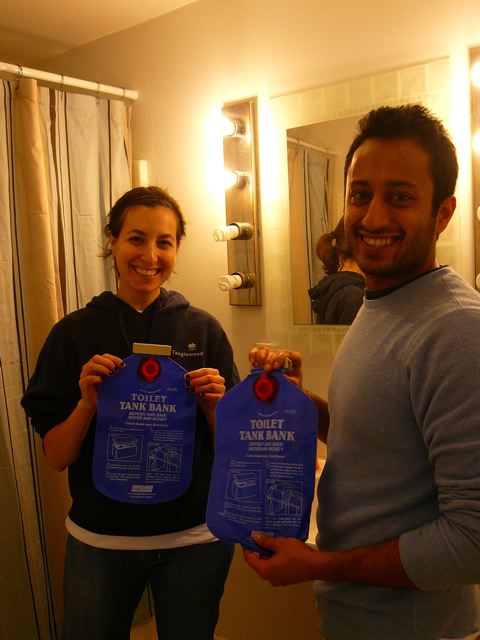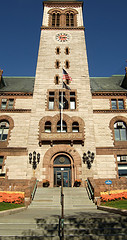Press Release: Green Shelter Project Underway at Transition House

Cambridge, MA — Transition House, Cambridge’s nonprofit domestic violence prevention agency, is greening its Emergency Shelter. The 120-year-old building buzzed with activity on Sunday, January 10, as Transition House kicked its Green Shelter Project into high gear with a modern-day weatherization barn-raising in partnership with the Home Energy Efficiency Team (HEET), the Cambridge Energy Alliance and New Generation Energy. “We were excited to have so many skilled and enthusiastic volunteers join together to make the Shelter more energy efficient and more comfortable for the 100 people who live there each year,” relayed Risa Mednick, chair of the Transition House Board. “We’re connecting the dots between environmental sustainability, energy conservation and sustaining vital programs in an era when domestic violence is on the rise and the needs of survivors far outstrips available resources.” “Every dollar we save on utility expenses will be redirected toward strengthening services our community depends on,” says Mednick.
Over 40 volunteers worked nonstop in groups led by HEET trainers sealing drafty basement leaks, caulking windows, installing low flow faucets and shower heads, replacing incandescent light bulbs with energy efficient compact florescents (CFLs) and weather stripping doorways. Former Mayor and City Councilor Denise Simmons, Councilor Sam Seidel and Councilor and State Representative Tim Toomey lent a hand. Transition House board members and the Middle East restaurant provided food for hungry workers. HEET donated all supplies and training and the Cambridge Energy Alliance donated CFL bulbs.
“In a few hours, we swapped out 50 light bulbs in 15 rooms, caulked all the windows and doors, fitted sinks with new aerators, and sealed over 140 feet of band joists that were a major source of heat loss,” reported Audrey Schulman, HEET’s president. Based on before and after measurements, HEET estimates a reduction of over $600 per year on heat and electricity bills. “We look for ways an organization like Transition House or an individual in their own home can realize big savings with small changes, says Schulman. One example: simply replacing the old bulbs in exit signs that operate 24/7 with high efficiency LEDs will save Transition House over $100 per year.
Chuck Lewin, founder of New Generation Energy ducked below basement pipes and beams as he sealed up air leaks remarking, “Every small thing each of us did here will have a lasting impact for Transition House. The environmental benefit can multiply if everyone applies what they’ve learned to their own homes and apartments.” HEET trainer Lilah Glick, of the Cambridge Energy Alliance led the team replacing thermostats with instruction in Spanish and English and shared that “programmable thermostats are an inexpensive way to reduce energy consumption, typically saving the average home over $150 dollars a year.”
Introducing low income homeless women to new skills that might spark their interest in green jobs and training opportunities is another important goal of the Green Shelter Project; engaging them in energy saving strategies as a part of budgeting and money management is also key.
Next steps for the organization include: continuing work with HEET to train staff and clients on changing work and lifestyle behaviors to increase energy conservation and savings; collaborating with New Generation Energy and the Cambridge Energy Alliance to monitor utility consumption patterns and assess the efficacy of renewable energy systems for the Emergency Shelter; and a green kitchen renovation.
###
About Transition House: Transition House, a nonprofit organization in Cambridge, MA, works to break the cycle of domestic violence. Transition House offers a continuum of safe, supportive housing options for individuals and families escaping abuse as well as prevention education in school and community settings. Since 1975, Transition House has been a lifeline to thousands of families as they rebuild their lives and has educated tens of thousands of youth in Cambridge and Greater Boston. www.transitionhouse.org
Partners in this green initiative include: the Home Energy Efficiency Team (www.heetma.org), Cambridge Energy Alliance (www.cambridgeenergyalliance.org) and New Generation Energy (www.newgenerationenergy.org) respected organizations with a shared interest in engaging public awareness and increasing participation in conservation and energy efficiency initiatives.
 Check out a recent story I wrote for Technology Review on a new plug ‘n’ play solar shingle from Dow Chemical. Dow plans to release a small test batch of the solar embedded shingles later this year and while they haven’t yet announced who will get them, I think they’d compliment my solar hot water system quite nicely.
Check out a recent story I wrote for Technology Review on a new plug ‘n’ play solar shingle from Dow Chemical. Dow plans to release a small test batch of the solar embedded shingles later this year and while they haven’t yet announced who will get them, I think they’d compliment my solar hot water system quite nicely.






 As world leaders gathered in Copenhagen,
As world leaders gathered in Copenhagen,  Massachusetts’ citizens will be gathering together tonight in solidarity with the citizens of those nations that will be first to face the impacts of climate change. The candlelight vigil is part of
Massachusetts’ citizens will be gathering together tonight in solidarity with the citizens of those nations that will be first to face the impacts of climate change. The candlelight vigil is part of